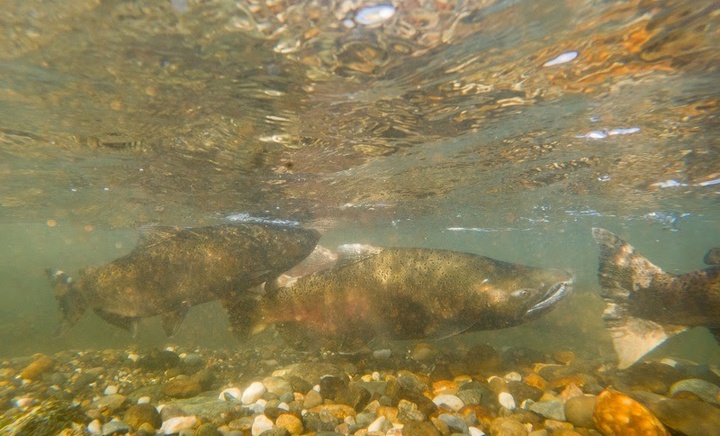Jessica Cejnar Andrews / Friday, March 29, 2024 @ 4:01 p.m. / Community, Environment, Tribal Affairs
Tolowa Dee-ni' Nation, Del Norte County Supervisors Ask State Fishery Managers For Smith River Salmon Season

Tolowa Dee-ni' Nation Tribal councilors and the Del Norte County Board of Supervisors are arguing for a salmon season for hatchery-raised chinook on the Smith River. | Photo courtesy of the California Department of Fish and Wildlife
(Updated at 8:43 p.m. to clarify that the Board of Supervisors supported the Tolowa Dee-ni' Nation's position that anglers should be allowed to keep hatchery-raised chinook even in seasons where wild chinook are prohibited.)
While the possibility of an ocean salmon season this year has yet to be decided, Del Norte County and Tolowa Dee-ni’ Nation officials are hoping state fishery managers will allow anglers to pursue hatchery-raised Smith River chinook.
Both the Board of Supervisors and the Tolowa Dee-ni’ Nation Tribal Council have sent letters to Tina Bartlett, the California Department of Fish and Wildlife’s northern regional manager.
In its letter dated Jan. 25, the Tribal Council said an emergency order last year that closed the fishery and omitted a daily bag limit for hatchery-raised salmon didn’t work with its conservation goals, nor that of the Rowdy Creek Fish Hatchery.
On Tuesday, District 3 Supervisor Chris Howard informed his colleagues of the Tolowa Dee-ni’ Nation’s concerns and asked them to weigh in. He noted that the California Fish and Game Commission manages the Smith River salmon fishery, along with fisheries on the Mad and Eel rivers.
“If hatchery fish, which are supposed to be retained and kept, aren’t fished for, it’s pointless to have a hatchery here,” he said.
The Fish and Game Commission closed the state’s recreational salmon fishing season in the Klamath River Basin and Central Valley rivers last May. It also closed the recreational fishery in the Smith and Eel rivers in a separate emergency action.
This action came after the Pacific Fishery Management Council closed the commercial and recreational ocean salmon fishery due to projected chinook salmon being at historic lows.
CDFW blamed the lowest stock forecasts on prolonged drought, the impact wildfires had on spawning and rearing habitat, algal blooms and ocean forage shifts.
However, CDFW didn’t include an exception for anglers to keep hatchery-raised salmon, which meant they would stay in the Smith River system, Tolowa Dee-ni' Nation Fisheries Division Manager Jennifer Jacobs said.
“This omission meant any hatchery chinook salmon returning in 2023-2024 would go unharvested… potentially increasing the opportunity for those fish to make it to the same available spawning grounds as wild fish returning to the watershed,” she said. “Hatchery fish are not intended to spawn with wild fish.”
The CDFW has yet to respond to the tribe, Jacobs said.
The Tolowa Dee-ni’ Nation purchased the Rowdy Creek Fish Hatchery in 2013 to ensure a subsistence harvest for its citizens, sport fishing opportunities and economic development for the community as well as providing environmental educational opportunities.
The hatchery raises steelhead and chinook. Its staff aims to release up to 80,000 steelhead and up to 150,000 chinook salmon into the Smith River each year, according to Jacobs.
Hatchery-raised chinook and and steelhead can be distinguished from their wild counterparts by the absence of their adipose fin, a small fleshy fin on their back between their dorsal fin and their tail.
Chinook raised at the Rowdy Creek Fish Hatchery also carry coded wire tags, Jacobs said.
“Most salmon and steelhead hatcheries operate to offset environmental damage for large projects such as dams or to raise and release Endangered Species Act-listed species,” she said. “RCFH is operated to supplement the sport fishery in the Smith River by raising and releasing fish that will return to the Smith River to be caught and eaten, not released.”
Under CDFW’s 2024-25 freshwater sport fishing regulations, anglers can keep up to five wild-caught chinook salmon. Current regulations on the Smith River prohibit the possession of wild-caught steelhead.
In its letter to Bartlett, the county endorses the Tolowa Dee-ni’ Nation’s request to allow anglers to keep hatchery-raised chinook during seasons when keeping wild chinook are prohibited. Del Norte County supervisors echo the TDN's concern about hatchery-raised chinook spawning with wild fish.
“It has been over a decade since [CDFW] and the [Fish and Game] commission prohibited wild steelhead retention while permitting hatchery raised steelhead be retained,” the Board of Supervisors wrote in its letter. “Not allowing for the retention of hatchery chinook while allowing the retention of hatchery steelhead simply isn’t sensible given the experience for how this fishery can be successfully managed. In addition, the Smith River chinook escapement is not reliant on PFMC/NOAA regulations as this is a separate fishery and entirely controlled by the state. With returns recorded over 22,000 for the 2023 fall run, it is imperative to reopen the 2024 season.”
In a March 11 news release, the Pacific Fishery Management Council is considering three options for a 2024 ocean salmon fishery off Washington, Oregon and California. Conserving Klamath and Sacramento fall chinook will be among the main constraints for this year’s ocean salmon fishery as will requirements to conserve coho salmon runs for the Fraser River, Washington coast and lower Columbia River.
The 2024 Klamath River fall chinook abundance is forecast at 180,700 adults. The 2024 stock abundance for Sacramento River fall chinook is at 213,600 adults, according to a March 13, 2024 news release.
The PFMC is expected to choose a season alternative at its meeting in Seattle from April 6-11. Its final recommendation will take effect by May 16.
CLICK TO MANAGE